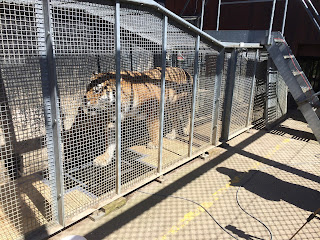We first went to Colchester Zoo last year (2015) to see if we could work with their felid collection. Having done a recon. of the site we figured we could work easily with their tigers and cheetah. But we needed a platform to put the forceplate within allowing the cats to walk steadily (not up or down hill or up/down steps).
Force plate platform
 |
| Platform setup showing how I put together the platform, with and undercut on one side allowing the cables to exit so the cats didn't chew on them. Red is the forceplate |
 |
| Platform (II) with plate installed. Cables were run out the left (my right in picture) and buried under wood |
So we had two days with the tigers and cheetah collecting data, although in truth the data collection only lasts an hour or two as we don't want to stress the cats.
 |
| Setting up the forceplate whilst being watched by the test subjects |
One thing that we would come to quickly learn, is that scaredy-cat works as a description for most species of felids. The tigers were initially less than happy to go onto the plates, even with food bribes.
The tigers would scrape the food back off the platform/plate and eat it. I have to say I was impressed by their dexterity and picking up food with a paw to get to their mouths, but it didn't help the data collection. We got them moving across the plate, but not how we wanted:
Eventually, after much coaxing, we did get them to walk over the plate. We (the incredibly helpful keepers) even managed to get them to manage a trot from time to time.
 |
| Tiger with right front foot on the plate (marked by the grey duct tape in the middle) |
Luckily Jack the cheetah was much easier. He has an area that he regularly paces when he is off exhibit between being fed and being let back out. As such we stuck out platform right there. We had the funny realisation though that after the first go, we needed to stick a log on the side nearest the fence otherwise Jack would continually walk down the side and not on the plate.
 | |
| Jack being a beautiful test subject with a nice right front foot on the plate |
Results
Whilst we do not have a full set of results to show you, I thought it would be useful to show what the output of forceplate is for those of you who don't know:
 |
| Force trace from one of the trials for a tiger |
End of part 1
So two days of work, we had a lot of data and a very busy student. Unfortunately due to the delays, we were unable to do anymore in 2015. However, that is not the end, and part two has actually just finished now so will appear imminently on the blog. It includes a lot more pretty pictures of exotic cats, as well as more successes, and some terrible failures.

No comments:
Post a Comment